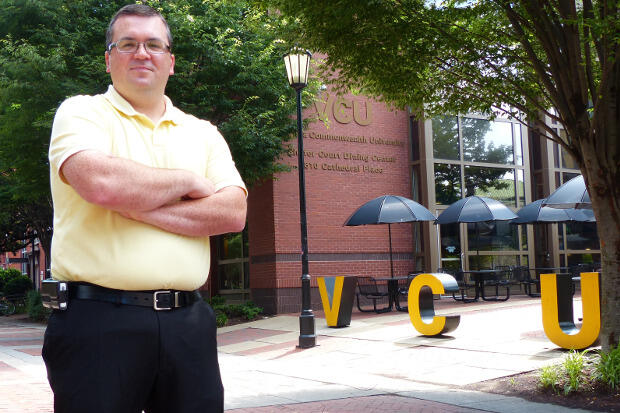
July 30, 2015
Emergency preparedness director gears up for bike race on heels of third book
Share this story
Adam Crowe works to create order out of situations, systems and information that appear to be – or really are – chaotic.
Crowe is Virginia Commonwealth University’s director of emergency preparedness, and with the world looking to Richmond for the UCI Road World Championships in September, he’s been very busy helping to create order. The international event is expected to attract approximately 450,000 spectators from Richmond and around the world.
Crowe is collaborating extensively with leaders, communicators, police, deans and human resources staff in preparation for the event. Externally, he’s assisting with the coordination of emergency response efforts with the City of Richmond, public safety agencies across the region and Richmond 2015, the local organizers who are staging the championships.
“I think planning is focused on the tension between creating a unique experience so people can take advantage of this world-class event, and protecting a premier academic institution,” Crowe said. “We’re protecting and preserving the VCU community as it exists while also leveraging the race as a learning opportunity.”
Crowe recently authored, “A Futurist’s Guide to Emergency Management,” in which he makes projections on theoretical scenarios in emergency management. His research aims to help other emergency managers, public safety and homeland security officials plan for future risks, but also to address questions that need to be answered now. He spoke with VCU News about some of the topics tackled in the book.
Success, failure, joy, anger, sickness, health – all that information is really going to come through those social media sources during a major event.
VCU is expecting a huge social media presence online during the bike race. How does your book explore social media in the context of emergency planning?
From the social media angle, that’s where the ground truth is about an event: Success, failure, joy, anger, sickness, health – all that information is really going to come through those social media sources during a major event. This being an international event, these will be international mediums that don’t change from country to country, or between socioeconomic levels – anyone can have these accounts.
Generally speaking, the deeper reasons why people crowd-source information following a disaster are varied; some people are truly altruistic while others may help for selfish reasons, such as to improve an online image of themselves.
What’s an example of emerging and disruptive technology?
Drones. After a disaster they can be used by safety officials for real-time situational awareness. They can give officials aerial imagery of places that may need debris removal, or can help determine what is exactly needed for timely and successful response and recovery efforts. However, drones can be militarized and used for terrorism or unmanned attacks, therefore making them disruptive as well. This dual usage is what defines an emerging, yet disruptive piece of technology.
Talk about how gender and sexuality roles should be a consideration for emergency managers.
The book takes a closer look at age, gender and sexuality and how those play into disaster relief efforts. In an emergency shelter there are traditionally bathrooms and showers based on gender. For transgendered individuals, this could lead to discomfort and possibly stigmas against them for using one space versus another. Obviously officials will want to provide safe, comfortable and usable spaces for those negatively impacted by a major event and they will need to consider the needs of a diverse population.
In your book you discuss “Black Swan” events. What are these and how do these impact the general public and emergency preparedness?
“Black Swan” events are, first off, unpredictable, and secondly, have a huge impact on society. People have inherent biases that make these events incomprehensible to the community and only in hindsight – after the tragedy – do people understand what lead to the catastrophe. Examples of Black Swan events include the September 11 attacks in 2001, the Deepwater Horizon spill in 2010 and the Fukushima nuclear meltdown in Japan in 2011. The effects on communities are dramatic, with both human and economic losses; as a result, the general public, outside of the disaster area, believes that a similar event could happen where they live. In reality, the chances of a smaller-scale, but hazardous weather event, is far more likely to impact a community than a Black Swan event. As a result, the fear of Black Swan events can also be highly exacerbated and preparedness efforts may focus on perceived risks to a community, rather than actual risks.
Crowe holds a master’s degree in public administration, with a focus in emergency management, from Jacksonville State University and has a bachelor’s degree in biochemistry from Clemson University. He became VCU's director of emergency preparedness in March of 2012. "A Futurist's Guide to Emergency Management" is his third book.
Featured image up top : Adam Crowe, VCU’s director of emergency preparedness, is helping lead campus preparations for the UCI Road World Championships in September.
Subscribe to the weekly VCU News email newsletter at http://newsletter.news.vcu.edu/ and receive a selection of stories, videos, photos, news clips and event listings in your inbox every Thursday.
Subscribe to VCU News
Subscribe to VCU News at newsletter.vcu.edu and receive a selection of stories, videos, photos, news clips and event listings in your inbox.











